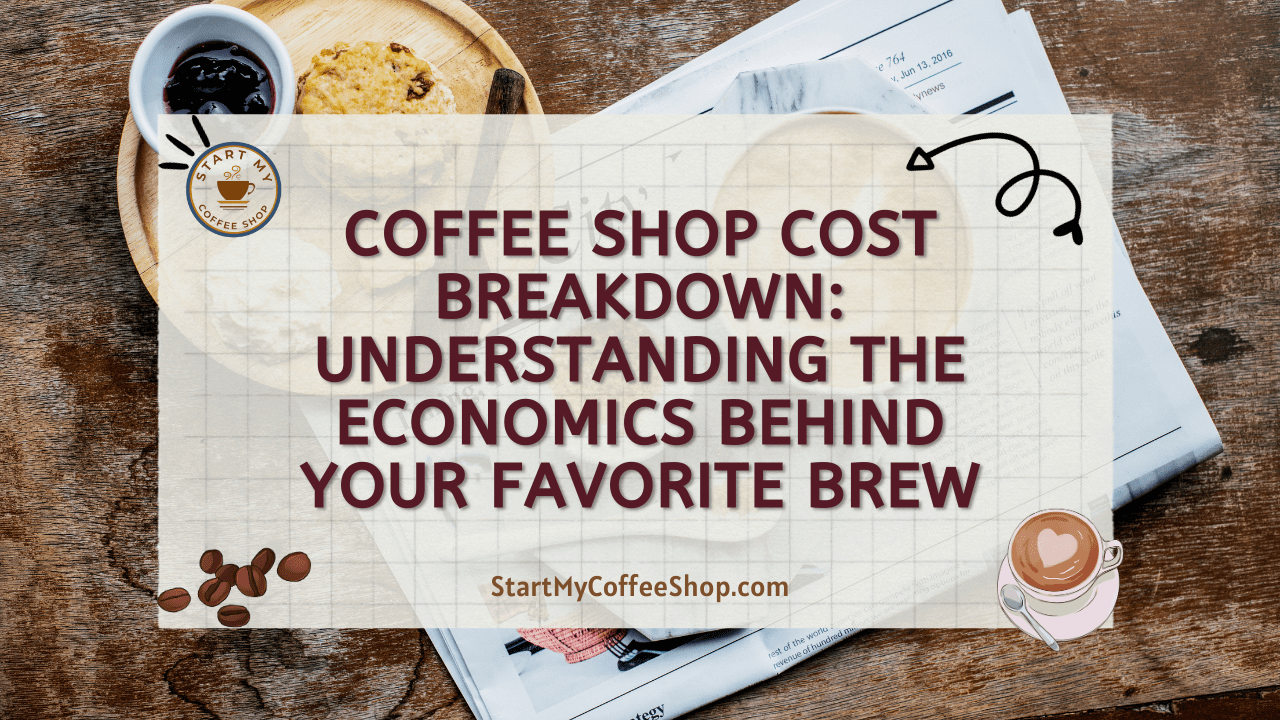Coffee shops have become an integral part of our daily lives, providing a welcoming environment to indulge in our love for aromatic beverages. However, have you ever wondered about the factors that contribute to the pricing of your favorite cup of joe?
Several factors contribute to the cost breakdown of a coffee shop like coffee beans, equipment, supplies, staffing, labor, utilities, marketing, and promotions. From the quality of the beans to the labor of the skilled baristas, each element contributes to the overall experience and price you pay.
In this article, I will delve into the fascinating world of coffee shop economics and explore the cost breakdown behind your daily brew. So, grab your favorite mug, sit back, and join us on this caffeinated journey into the world of coffee shop cost breakdown.
Coffee Beans: The Foundation of Your Cup
When it comes to the cost breakdown of a coffee shop, the quality and sourcing of coffee beans play a pivotal role. Coffee beans are the heart and soul of the industry, and their impact on the taste and overall experience of your beloved brew cannot be overstated. Specialty coffee shops, in particular, prioritize sourcing beans from reputable growers who emphasize quality and sustainability.
Specialty coffee shops often pay a premium for beans with unique flavors and origins. These beans are meticulously cultivated and processed to bring out the best flavors and characteristics. The additional care and attention given to specialty beans result in a higher price point compared to more conventional coffee beans.
The cost of coffee beans can vary significantly based on several factors. The variety of the beans, such as Arabica or Robusta, plays a role in determining the price. Arabica beans are generally considered to have superior quality and are often priced higher than Robusta beans.
Origin is another key factor in the cost variation. Coffee beans sourced from specific regions known for their exceptional flavors and growing conditions, such as Ethiopia, Colombia, or Costa Rica, tend to be more expensive due to their unique profiles.
Moreover, certifications like fair trade or organic also influence the cost of coffee beans. Fairtrade certification ensures that farmers receive fair compensation for their products, which can contribute to higher prices. Organic certification indicates that the beans are grown without the use of synthetic pesticides or fertilizers, leading to additional costs in the cultivation process.
Coffee shop owners carefully consider these factors when procuring beans for their establishment. They aim to strike a balance between offering high-quality, ethically-sourced beans and managing the cost implications. This delicate equilibrium ensures that customers enjoy a premium coffee experience while supporting sustainable practices in the coffee industry.
So, the next time you sip your favorite cup of coffee at your local specialty coffee shop, take a moment to appreciate the intricate cost breakdown that goes into sourcing those premium beans. The investment made by coffee shop owners in procuring high-quality beans ensures that you can savor the unique flavors and aromas that make your daily coffee ritual a truly exceptional experience.
Read more about: Business Plan to Open a Coffee Shop: A Cup of Dreams
Equipment and Supplies: Brewing Excellence

In the world of coffee shops, investing in top-notch brewing equipment is crucial to ensure consistent quality and flavor. Espresso machines, grinders, and other specialized tools form the backbone of a coffee shop’s operation. These essential equipment pieces come with a substantial price tag, reflecting their advanced features, precision, and durability.
Espresso machines, the workhorses of the coffee industry, can range from a few thousand dollars to tens of thousands, depending on their complexity and capabilities. High-quality grinders are equally important, as they allow baristas to extract the perfect grind size for each coffee preparation method. Drip brewers, pour-over setups, and alternative brewing equipment also contribute to a coffee shop’s investment in providing diverse and excellent coffee offerings.
However, it’s not just the initial cost of the equipment that coffee shops need to consider. Ongoing expenses associated with equipment maintenance and repair are part of the cost breakdown. Coffee shops must allocate a budget for regular servicing, cleaning, and calibration to ensure optimal performance and longevity of their equipment. Additionally, they need to plan for potential replacement costs as equipment wears out over time.
In addition to machinery, coffee shops require a range of supplies to serve their customers. Items like filters, cups, lids, stirrers, and other accessories may seem insignificant individually, but their collective cost can quickly accumulate. Considering the volume at which these supplies are utilized in a bustling coffee shop, it becomes evident that the expenses associated with stocking and replenishing them should not be overlooked.
To maintain a consistent and high-quality coffee experience, coffee shop owners carefully select and invest in the right equipment and supplies. By doing so, they ensure that baristas have the tools they need to create exceptional beverages while meeting the demands of their customers. The investment in equipment and supplies ultimately contributes to the overall cost breakdown of a coffee shop, reflecting the commitment to excellence and customer satisfaction.
Staffing and Labor: The Human Touch
The true magic of a coffee shop lies in the hands of its baristas. These skilled and dedicated individuals are the driving force behind every perfectly brewed cup of coffee. The labor cost associated with baristas is a significant component of the overall cost breakdown for coffee shops.
Baristas are the artists who transform coffee beans into delightful beverages. Their expertise extends beyond simply pulling shots or frothing milk. They are responsible for understanding the complexities of different coffee varieties, mastering brewing techniques, and ensuring consistency in taste and quality. Their artistry, precision, and attention to detail elevate the coffee shop experience and keep customers coming back for more.
Given the specialized nature of their work, skilled baristas often command higher wages. Coffee shop owners recognize the value of their expertise and are willing to invest in their talent to provide customers with exceptional coffee. The demanding nature of the job, which requires multitasking, maintaining a calm demeanor during busy periods, and delivering excellent customer service, contributes to the higher wages that skilled baristas typically earn.
Beyond the baristas, coffee shop owners must account for additional labor costs. Managerial staff plays a vital role in overseeing operations, managing inventory, and ensuring smooth day-to-day functioning. Cleaning crews are essential for maintaining a clean and hygienic environment, both in the front-of-house and back-of-house areas. Administrative personnel handles tasks such as scheduling, payroll, and bookkeeping, which are vital for the smooth functioning of the business.
Each member of the coffee shop team contributes to the labor cost breakdown, reflecting the investment in human resources required to run a great establishment. Coffee shop owners recognize the importance of building a capable and motivated team that can deliver exceptional coffee and provide a welcoming atmosphere for customers.
Rent and Utilities: A Place to Call Home

Coffee shops require a physical space to create a welcoming environment for their customers, and this comes with associated costs. Rent is a significant factor in the cost breakdown, as it varies based on location, size, and local market conditions. Prime locations in bustling city centers typically command higher rents due to the potential for greater foot traffic and visibility. On the other hand, coffee shops in suburban or less central areas may find more affordable rent options while potentially sacrificing some customer traffic.
In addition to rent, utility expenses contribute to the operational costs of a coffee shop. These include electricity, water, heating, and other essential utilities. The amount spent on utilities can fluctuate depending on various factors. The climate plays a role, as coffee shops in colder regions may require more heating during winter months. The size of the establishment also affects utility costs, as larger spaces generally require more energy to power and maintain. The equipment used within the coffee shop, such as espresso machines, refrigerators, and lighting systems, also contributes to the overall utility expenses.
Coffee shop owners must carefully consider the balance between location, rent costs, and potential customer reach when selecting a space. While prime locations offer visibility and potential for higher sales, they come with higher overhead expenses. Suburban or less central locations may provide more affordable rent options but could potentially have a smaller customer base. Balancing these factors is crucial in determining the economic viability of the coffee shop.
To ensure profitability, coffee shop owners need to manage rent and utility costs effectively. This may involve negotiating favorable lease agreements, implementing energy-saving practices, or investing in efficient equipment to minimize utility expenses. Striking the right balance between location, rent, and utility costs is essential for a coffee shop’s financial sustainability.
Read more about: Business Plan to Open a Coffee Hut: From Dreaming to Brewing
Marketing and Promotion: Spreading the Coffee Culture
In the competitive world of coffee shops, effective marketing and promotion are essential for attracting customers and establishing a strong brand identity. Coffee shop owners understand the importance of investing in marketing efforts to create awareness, build loyalty, and differentiate themselves from the competition. However, these marketing expenses contribute to the overall cost breakdown.
Modern marketing strategies often involve digital platforms and social media campaigns. Coffee shops allocate resources to maintain an active online presence, engaging with customers through platforms like Instagram, Facebook, Twitter, and more. This includes creating captivating content, running targeted advertisements, and responding to customer inquiries and reviews. Additionally, coffee shops may invest in website maintenance and optimization to ensure a user-friendly experience for customers searching for information or placing orders online.
Printed materials such as menus, flyers, business cards, and signage also factor into the marketing expenses. These materials help communicate the coffee shop’s offerings, promotions, and brand identity to potential customers. Coffee shops may collaborate with graphic designers or printing services to create visually appealing and professional materials that effectively convey their message.
Engaging with the local community is another aspect of coffee shop marketing. This can involve participating in community events, sponsoring local organizations, or hosting fundraisers. These activities help build a positive image for the coffee shop and foster relationships with the community. Collaborating with influencers or local bloggers to promote the coffee shop can also be a part of the marketing strategy, requiring financial investments in terms of product samples or compensating influencers for their services.
Summary
The next time you sip your favorite coffee at your beloved coffee shop, take a moment to appreciate the intricate cost breakdown that goes into crafting that perfect cup. By understanding the economics behind your favorite brew, you gain a deeper appreciation for the dedication and craftsmanship that goes into running a coffee shop. So, the next time you enter a coffee shop, marvel at the intricate dance of flavors, the comforting ambiance, and the smiling baristas, knowing that your payment supports a delicate balance of costs and passion for coffee.
Frequently Asked Questions
1. Why are specialty coffee beans more expensive?
Specialty coffee beans are often more expensive due to their superior quality, unique flavors, and the ethical practices involved in their sourcing. These beans are meticulously cultivated and processed, resulting in a higher price point compared to conventional coffee beans.
2. How much does coffee shop equipment cost?
The cost of coffee shop equipment can vary depending on the specific needs and scale of the establishment. High-quality espresso machines can range from a few thousand dollars to tens of thousands, while other brewing equipment’s and supplies add to the overall expense.
3. What factors affect the price of a cup of coffee at a coffee shop?
Several factors influence the price of a cup of coffee, including the quality and origin of the beans, the labor, and skill of the baristas, the rent and utilities of the location, and the marketing efforts employed by the coffee shop.
To learn more on how to start your own coffee shop, check out my startup documents here.
Disclaimer: The information provided by StartMyCoffeeShop.com (“The Site”) is for general informational purposes only. All information on the Site is provided in good faith. However, we make no representation or warranty of any kind, express or implied, regarding the accuracy, adequacy, validity, reliability, availability, or completeness of any information on the Site. Under no circumstance shall we have any liability to you for any loss or damage of any kind incurred as a result of the use of the Site or Reliance on any information provided on the Site. Your use of the Site and reliance on any information on the Site is solely at your own risk. This blog post is for educational purposes only and does not constitute legal advice. Please consult a legal expert to address your specific needs. Terms and Conditions. (https://startmycoffeeshop.com/terms-and-conditions/)

Hi! I’m Shawn Chun
My adventure in coffee began when I first launched my first coffee shop back in the early 2000s. I had to figure out so many things on my own and to make it worse within 2 years of opening two large corporate coffee chains moved in just blocks away from me!
As I saw smaller and even some larger coffee shops in the neighborhood slowly lose customers to these giant coffee chains and slowly close up shop, I knew that I had to start getting creative…or go out of business.
I (like you may be) knew the coffee industry well. I could make the best latte art around and the foam on my caps was the fluffiest you have ever seen. I even had the best state-of-the-art 2 group digital Nuova Simonelli machine money could buy. But I knew that these things alone would not be enough to lure customers away from the name brand established coffee shops.
Eventually, through lots of trial and error as well as perseverance and creativity I did find a way to not only survive but also thrive in the coffee/espresso industry even while those corporate coffee chains stayed put. During those years I learned to adapt and always faced new challenges. It was not always easy, however, in the end, I was the sole survivor independent coffee shop within a 10-mile radius of my location. Just two corporate coffee chains and I were left after that year. All told the corporate coffee chains took down over 15 small independent coffee shops and kiosks and I was the last one standing and thriving.
Along the years I meet others with the same passion for coffee and I quickly learned that it is not only “how good a barista is” that makes a coffee shop successful, but the business side of coffee as well.
Hence why I started this website you are on now. To provide the tools and resources for up and coming coffee shop owners to gain that vital insight and knowledge on how to start a coffee shop successfully.
Stick around, browse through my helpful blog and resources and enjoy your stay! With lots of LATTE LOVE!
Shawn






